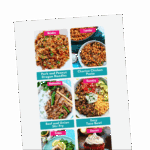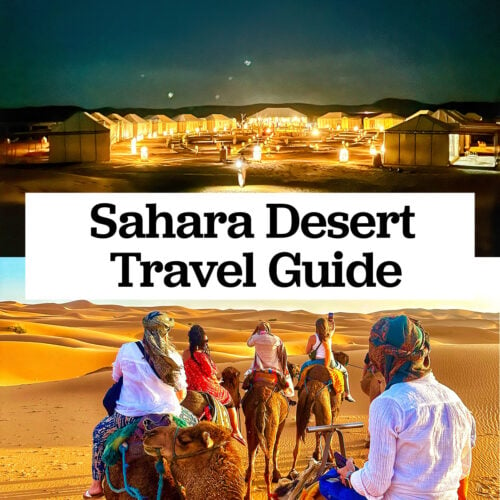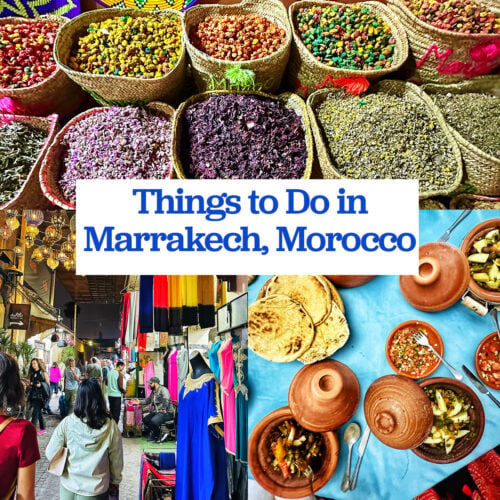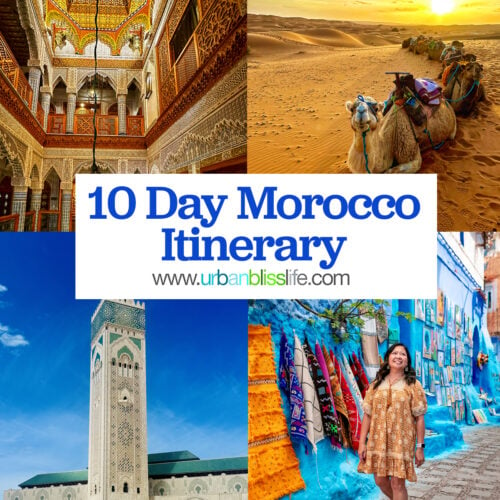Traditional Moroccan food is a beautiful blend of richly spiced meats and seafoods, with vegetable-forward sides and a tapestry of bread options. Here are some of the best food in Morocco to try while traveling or at home.
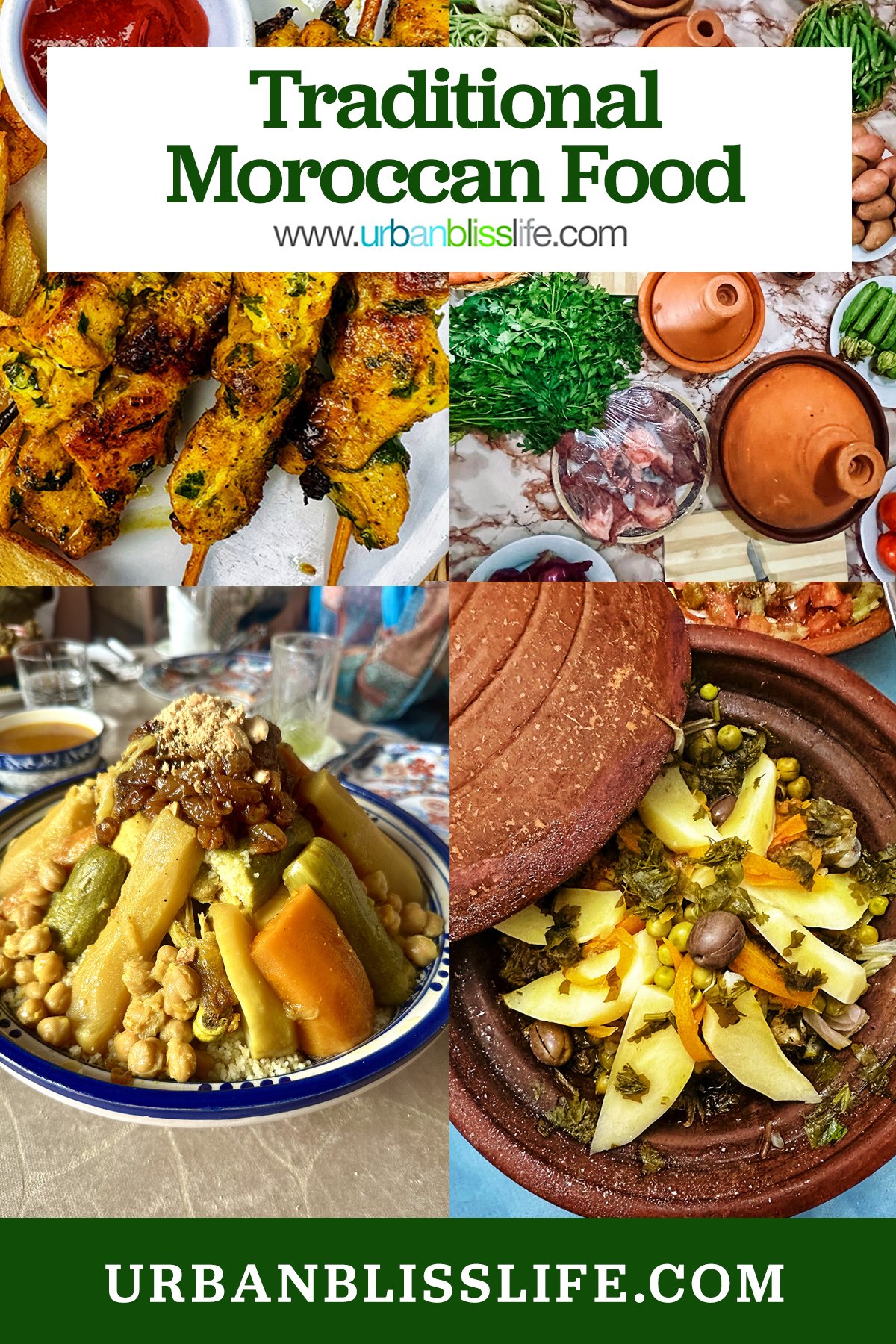
I fell in love with Moroccan food well before I first traveled to Morocco.
The tapestry of aromatic spices, the beautiful sweet pastries, the flavor foundation of well seasoned couscous. The flavors of Morocco inspired me to create my Instant Pot Moroccan Chicken recipe.
And since many of you have told me you’ve incorporated that recipe into your own regular dinner rotation, I thought I’d share more Moroccan food to inspire your tastebuds!
If you want to know more about traditional Moroccan food, I’m including 20 of the top Moroccan dishes you can find throughout the country. From the bustling food stalls of Marrakech’s Jemaa el-Fnaa square to the coastal towns of Tangier and the sun-drenched Sahara desert, Moroccan food is as diverse as its landscapes.
We feasted well during our 10 day trip to Morocco, as you’ll see from these photos of the dishes we ate.
Ready to take a culinary journey to Morocco? Let’s go!
Jump to:
- About Moroccan cuisine
- 1. Chicken Tagine with Preserved Lemons and Olives
- 2. Couscous Tfaya
- 3. Pastilla (B’stilla)
- 4. Harira
- 5. Chebakia
- 6. Raib
- 7. Ghriba (Moroccan almond cookies)
- 8. Zaalouk
- 9. Baghrir
- 10. Khobz
- 11. Tangia
- 12. Moroccan chicken skewers
- 13. Msemmen
- 14. Batbout
- 15. Tagine Al Hout
- 16. Almond Briouat
- 17. Taktouka
- 18. Jowhara (Milk Bastilla)
- 19. Kaab el Gazelle
- 20. Mhencha
- Frequently asked questions
- Wines that pair beautifully with Moroccan food
- More Morocco food, wine, and travel
About Moroccan cuisine

Moroccan cuisine is a vibrant tapestry woven from centuries of Berber, Arab, Andalusian, and French culinary traditions.
With its strategic location between Africa, Europe, and the Middle East, Morocco became a cultural melting pot. And its cuisine reflects layers of influence through aromatic spices, time-honored cooking techniques, and bold, unforgettable flavors.
Staple ingredients like olive oil, preserved lemons, saffron, cinnamon, cumin, and Ras el Hanout (a complex spice blend) come together in soulful harmony in every dish.
Tagines bubbling with rich sauces, sweet-and-savory pastries, and fragrant couscous dishes have become emblematic of Moroccan hospitality. Whether you’re feasting in a riad courtyard or at a roadside café, you’ll find every bite tells a story of family, tradition, and flavor.
1. Chicken Tagine with Preserved Lemons and Olives

A national favorite, this tagine simmers chicken with preserved lemons, green or purple olives, garlic, turmeric, and saffron. It’s tangy, salty, and richly aromatic. Especially popular in Fes and Casablanca, it’s often served with crusty bread to soak up the golden sauce. The preserved lemon, a distinctly Moroccan ingredient, is a game-changer.
2. Couscous Tfaya

Traditionally served on Fridays after prayer, this couscous dish is topped with caramelized onions, sweet raisins, and cinnamon. It’s usually paired with tender lamb or chicken and chickpeas. A North African staple, couscous originated with the Berbers, and Tfaya is especially beloved in Rabat and Marrakech.
3. Pastilla (B’stilla)

A savory-sweet pastry from Fes, pastilla layers pigeon or chicken with almonds, cinnamon, and eggs inside phyllo dough. It’s dusted with powdered sugar and cinnamon. Elegant and complex, it’s often served at weddings and special gatherings.
4. Harira

A hearty tomato-based soup with lentils, chickpeas, lamb, and broken vermicelli, harira is a Ramadan essential. It’s nourishing and comforting, often garnished with lemon and fresh coriander. While enjoyed year-round, it’s most symbolic in Fes and other northern regions.
5. Chebakia
Included in the photo above with Harira soup, Chebakia is a Ramadan favorite. This deep-fried sesame cookie shaped into a flower and soaked in orange blossom honey. Crunchy, sticky, and floral, it’s served alongside harira to break the fast.
6. Raib

This creamy, light yogurt is a popular breakfast or snack in Moroccan households. It’s also often enjoyed during the Iftar meal that breaks the fast during Ramadan.
7. Ghriba (Moroccan almond cookies)

Ghriba are Moroccan almond cookies that are a celebrated symbol of hospitality and festivity. We were welcomed with these cookies when we checked into the Riad Salam Fes. They’re so good!
The almond is a symbol of prosperity and festivity in Moroccan culture. And these Moroccan cookies are often prepared for weddings, holidays, and family gatherings.
8. Zaalouk

This smoky eggplant and tomato salad is cooked down with olive oil, garlic, paprika, and cumin until velvety. Served cold or warm, zaalouk is a staple mezze item across the country, especially in home kitchens and casual cafés.
9. Baghrir

These spongy “thousand-hole” pancakes are made with semolina and yeast, soaked with butter and honey. Light and airy, baghrir is a traditional breakfast treat across all of Morocco, especially in Berber villages.
10. Khobz

This round, crusty bread (pictured above with a classic Moroccan salad) is essential at every Moroccan table. We encountered it at almost every meal during our trip.
Baked daily in communal ovens, khobz is often served with tagines, stews, and dips, as it’s a great bread to soak up those delicious sauces and dips. You’ll find slight regional variations, but its dense yet fluffy texture remains a constant.
11. Tangia

A Marrakesh specialty, tangia is slow-cooked beef or lamb stewed with preserved lemon, garlic, cumin, and saffron inside a clay urn. Traditionally made by men and cooked in communal ovens, it’s the ultimate bachelor’s dish.
12. Moroccan chicken skewers

We found Moroccan chicken skewers at many restaurants in the medinas and souks of Fes, Marrakesh, and Tangier. These deliciously spiced tender skewers of chicken are often served with Charmoula sauce.
13. Msemmen

Msemmen are flaky, pan-fried square flatbread served at breakfast or tea time, often with honey or cheese. But you can also find savory versions.
Originating in Amazigh (Berber) households, it’s a must-try in Casablanca, Marrakesh and many other cities around Morocco. My favorite version is a plain msemmen served with a hazelnut chocolate dip, similar to Nutella. Yum!
14. Batbout
Known as Moroccan pita, batbout is a small pan-cooked bread that puffs up when grilled. It’s often stuffed with spiced meats, cheese, or vegetables for quick sandwiches—perfect street food in Casablanca.
15. Tagine Al Hout

This slow-simmered seafood tagine is a favorite is often a beautiful combination of white fish, calamari, and/or shrimp with vegetables and chermoula sauce. Served bubbling hot, it celebrates Morocco’s coastline.
My friend enjoyed this dish at the Hilton Tangier Al Houara Resort & Spa’s restaurant, L’Olivier.
16. Almond Briouat

Almond briouats (the triangle-shaped pastries in the photo above) are a popular Moroccan pastry made with thin, crispy pastry shells filled with a mixture of ground almonds, sugar, and spices.
These triangles are then fried and often dipped in warm honey or other sweet syrup. They are a common treat, especially during Ramadan and for special occasions.
We found these at a shop within the souks of Marrakech.
17. Taktouka

Think of it as a Moroccan salsa—chopped tomatoes often with roasted peppers, cooked down with olive oil, garlic, and paprika. It’s fresh, smoky, and often eaten cold as part of a mezze platter.
18. Jowhara (Milk Bastilla)

Milk Bastilla, also known as Jowhara (translation: “jewel”), is a traditional Moroccan dessert featuring a pastry shell filled with a sweet milk cream and flavored with orange blossom water.
The dessert is often served at celebrations and special occasions. We enjoyed the dessert above at Restaurant Soultana in Fes.
19. Kaab el Gazelle
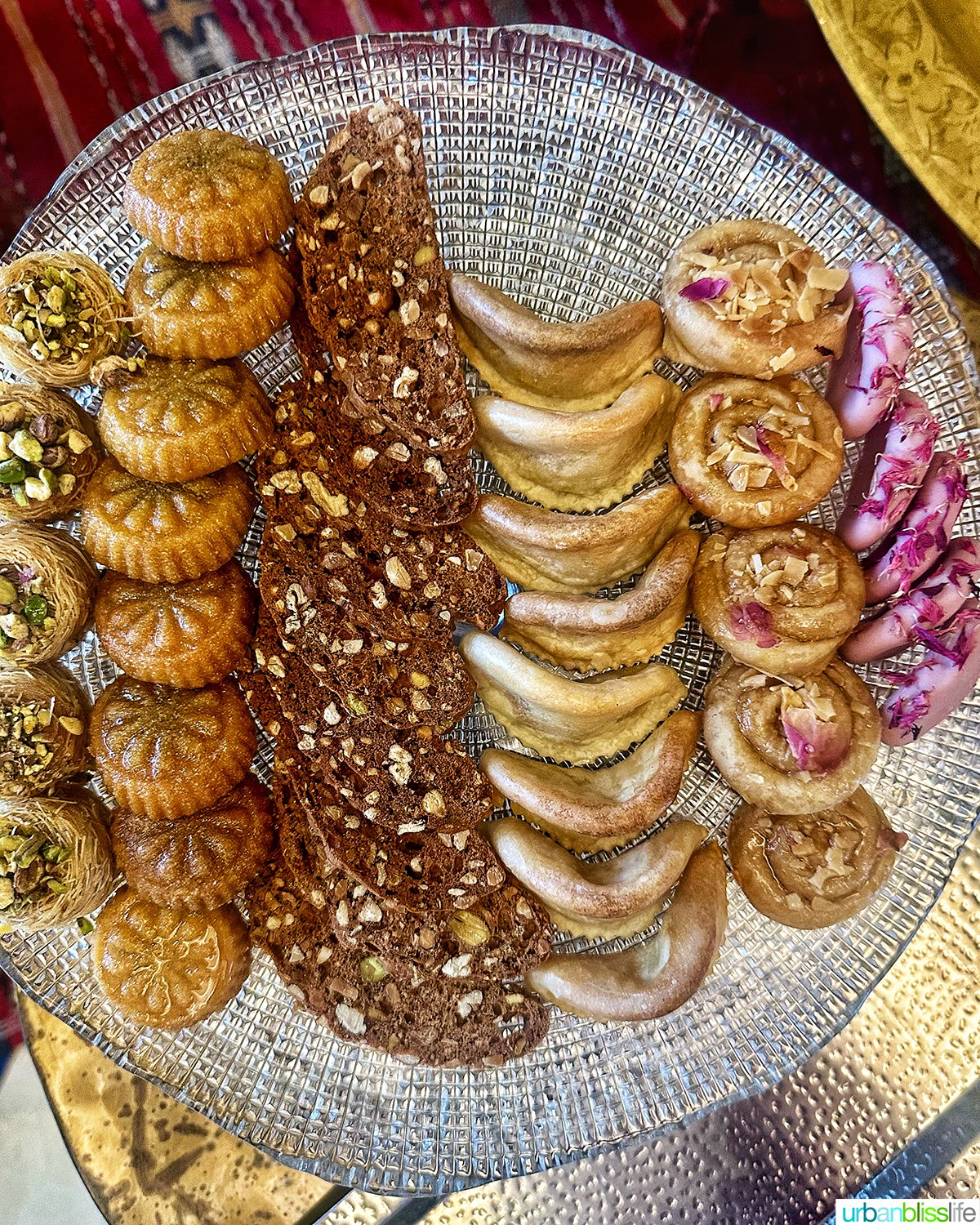
Kaab el Gazelle are traditional crescent-shaped cookies of the Maghreb (pictured above, 4th pastry from the left). They’re filled with almond paste and orange blossom.
20. Mhencha
M’hencha (pictured above, the 2nd pastry from the right, next to the Kaab el Gazelle) are a traditional Moroccan sweet pastry. Known as “snake cake” due to its spiral shape, it has roots in Berber and Arab culinary traditions. The pastry is made with thin layers of filo pastry and filled with a sweet paste of almonds, pistachios, and orange blossom.
Frequently asked questions
I find that it’s not usually spicy in terms of heat. However, Moroccan food is richly spiced—think cinnamon, cumin, ginger, turmeric. So flavorful! But rarely hot heat like Indian or Mexican cuisine. Harissa is the exception if you want a fiery kick.
A tagine is both a dish and the name of the conical clay pot it’s cooked in. The shape helps steam condense back into the dish, creating tender, slow-cooked meals with minimal water.
Absolutely! Dishes like zaalouk, taktouka, lentil stews, vegetable tagines, and couscous are often meat-free and packed with flavor.
The bold blend of sweet and savory flavors, common use of preserved lemons (so tasty!), and the tradition of combining fruits like dates or raisins with meats are some things that help set Moroccan cuisine apart.
Olive oil is king in Moroccan kitchens, though you’ll also find smen (fermented butter) used in traditional recipes for added depth.
Yes, in most tourist-frequented areas. Just look for stalls with high turnover and locals eating there. We ate a ton of street food and nobody got sick on our trip to Morocco. Always drink bottled water to be safe.
Wines that pair beautifully with Moroccan food

Although Morocco is predominantly a Muslim country, you will be able to find alcohol served in licensed restaurants and hotels throughout the country. Morocco also has its own wine industry, with a variety of white, red, and rosé wines produced here.
In pairing wines with Moroccan flavors, here are my top three recommendations:
White wine: Gewürztraminer
This aromatic white with notes of lychee and rose balances the warm spices and sweetness found in dishes like pastilla or couscous tfaya.
Red wine: Pinot Noir
Light and fruit-forward, Pinot Noir complements lamb tagine and grilled meats without overpowering the spices.
Rosé wine: Rosé from Provence or Morocco’s own Meknes region
Crisp, floral, and dry—rosé cuts through the richness of dishes like rfissa or mechoui and pairs beautifully with salads and seafood.
More Morocco food, wine, and travel
✈️ Planning a trip?
Here are my favorite items and resources I use whenever I travel.
🧳 Away Luggage – I’ve traveled all over the world with Away luggage and can’t say enough about their durability and style.
🎒 Backpack – This is my go-to travel backpack. It has pockets everywhere and enough space to fit everything from my laptop to extra shoes.
📍Apple Air Tags – I always hide these airtags away in my luggage, especially if I check bags. That way I can track them and know exactly where they are.
👚 Packing cubes – Take the stress out of packing and make sure everything fits in your bags with this set of compression packing cubes.
⚡️Portable charger – I always travel with a portable power bank for my devices, and I’ve found this one to be the most reliable and long-lasting.
🔌 Travel adapter – Planning to travel to multiple countries? I use this all-in-one international travel adapter to make sure my devices work wherever I go.
🛩 Flights – I’ve found the best savings savings on flights here.
🏨 Hotel – I always snag the best lodging deals with this booking tool.
🚙 Rental cars – You can get some great savings on rental cars on this site.
I use all of these products and earn a small commission through these affiliate links.
